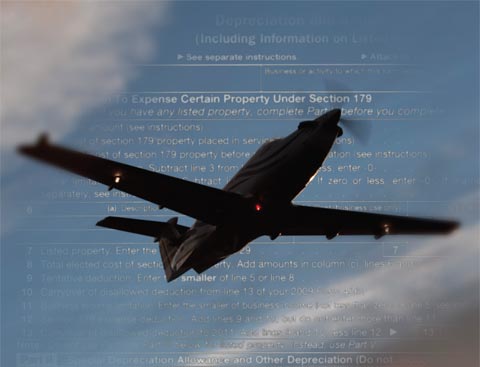Sales revival
Major tax incentives spur aircraft sales

Sales of new general aviation aircraft fell off a cliff in 2009 and remained depressed until the fourth quarter of last year. And then, airplane-dealer phones started ringing again.
The calls—and a healthy spurt of new sales—were driven by strong tax incentives that allow new aircraft buyers who use their airplanes for business to claim up to 100-percent depreciation in their first year of ownership. The unusually generous terms have been extended through 2011; they drop back to 50 percent in 2012 and expire the next year.
“The sales impact of 100-percent depreciation was dramatic when it was offered in December,” said Mike Fitzgerald, executive vice president at Skytech, a Piper and Pilatus dealer in Maryland. “We had a very good December, and taxes were a factor in 80 percent of the sales we made—including a PC-12 that we delivered on December 31.”
Bonus depreciation allows new aircraft buyers to dramatically reduce their tax obligations. For example, a buyer of a new $1 million business aircraft who normally pays combined federal and state taxes of 40 percent can reduce tax obligations by $400,000 in the first year of aircraft ownership through 100-percent depreciation.
Of course, businesses or individuals must have significant taxable incomes for bonus depreciation to matter. And new aircraft buyers can claim the write-off for the first $2 million of aircraft value only. Above that amount, standard deductions apply.
Keith Martinich, a Maryland aircraft dealer who sells Quest Kodiak utility airplanes, says some business buyers who were considering used aircraft are shifting to new models instead.
“For businesses with strong financials, tax incentives can make buying a new Kodiak for $1.8 million a better deal than buying a pre-owned one,” he said. “If an aircraft is the right business tool, there’s never been a better time to buy one.”
Special tax breaks also are available for aircraft owners who upgrade business aircraft with new equipment. An avionics upgrade, for example, purchased after September 8, 2010, and put into service in calendar 2011, may also qualify for 100-percent accelerated depreciation under the law signed by President Barack Obama on December 17, 2010.
The law also allows IRS Section 179 deductions up to 100 percent of the first $500,000 spent to purchase new or used aircraft in 2010 or 2011, although many restrictions apply. The amount of any Section 179 deduction also is limited by the amount of taxable income from aviation-related activities, according to Raymond C. Speciale, a CPA and author of AOPA’s A Pilot’s Guide to Taxes.
New GA aircraft deliveries fell 11.4 percent in 2010 to 2,015, the third successive annual drop. Total billing increased in 2010, however, to $19.7 billion from $19.5 billion. Business-jet deliveries fell 12.3 percent to 763; turboprops declined 17.7 percent to 363; and piston aircraft dropped 7.7 percent to 889.
Aircraft manufacturers point to a rise in global economic growth, corporate profits, and aircraft usage as indications that a rebound in business aircraft sales is likely this year.
Boni Caldeira, a Cirrus salesman in the Washington, D.C., area, said the tax incentives apply to every new aircraft in the Cirrus fleet, and he’s seen an increase in sales since the fourth quarter. Cirrus has a list of accountants who specialize in aircraft tax planning, and Caldeira said he refers customers directly to them for their expertise.
“These are by far the most generous tax incentives I’ve ever seen for new aircraft purchases,” he said. “If buyers don’t have enough taxable income to deduct the full price of the aircraft in one year, they have the flexibility to spread it out over multiple years. It’s really extraordinary.”
Deeply discounted prices on some used aircraft had been depressing new-aircraft sales for at least the past two years, but Skytech’s Fitzgerald said bonus depreciation is evening the balance.
Around 10 percent of the U.S. general aviation fleet is typically for sale at any given time, and Fitzgerald said the current inventory level for owner-flown aircraft is unusually low, at roughly 5 percent. But used-aircraft prices have remained soft as worried sellers are willing to part with airplanes at fire-sale prices. That’s good news for used-aircraft buyers, but it lowers the value of trade-ins and makes new-aircraft sales harder to consummate.
Aircraft loans are available at rates of 6 percent and sometimes less, and 20-year terms.
Fitzgerald said less restrictive terms are needed to boost new aircraft sales going forward.
“It used to be that a good credit history was enough for any bank,” he said. “Now the lending market has tightened up tremendously, and borrowers are being scrutinized. We all know about the excesses in the housing market. But now the pendulum has swung too far in the opposite direction, and we need to see the lending environment for aircraft loans loosen up.”


